![]()
![]()
![]()
Use LEFT and RIGHT arrow keys to navigate between flashcards;
Use UP and DOWN arrow keys to flip the card;
H to show hint;
A reads text to speech;
109 Cards in this Set
- Front
- Back
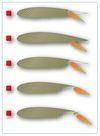
What is a fowler flap? a. 2 b. 3 c. 4 |
c. 4 |
|
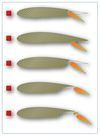
what is a slotted flap? a. 1 b. 3 c. 4 |
b. 3 |
|

what is a split flap? a. 2 b. 3 c. 4 |
a. 2 |
|
|
Which type of flap creates the greatest change in pitching moment?
a. Plain. b. Split. c. Fowler. |
c. Fowler. |
|
|
Which type of flap creates the least change in pitching moment? a. Split. b. Fowler. c. Slotted. |
a. Split. |
|
|
Which type of flap is characterized by large increases in lift coefficient with minimum changes in drag? a. Split. b. Fowler. c. Slotted. |
b. Fowler. |
|
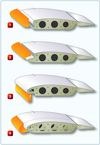
Which of the following illustrations is a fixed slot? a. 1 |
a. 1 |
|
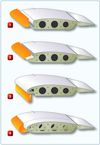
Which of the following illustrations is a movable slot? a. 1 b. 2 c. 3 |
b. 2 |
|
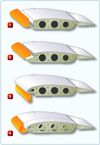
Which of the following illustrations is a leading edge cuff? a. 2 b. 3 c. 4 |
c. 4 |
|
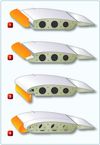
Which of the following illustrations is a leading edge flap? a. 1 b. 2 c. 3 |
c. 3 |
|
|
Which statement relates to Bernoulli’s principle? a. For every action there is an equal and opposite reaction. b. An additional upward force is generated as the lower surface of the wing deflects air downward. c. Air traveling faster over the curved upper surface of an airfoil causes lower pressure on the top surface. |
c. Air traveling faster over the curved upper surface of an airfoil causes lower pressure on the top surface. |
|
|
An aircraft wing is designed to produce lift resulting from a. Negative air pressure below the wing’s surface and positive air pressure above the wing’s surface. b. Positive air pressure below the wing’s surface and negative air pressure above the wing’s surface. c. A larger center of pressure above the wing’s surface and a lower center of pressure below the wing’s surface. |
b. Positive air pressure below the wing’s surface and negative air pressure above the wing’s surface.
|
|
|
During flight with zero angle of attack, the pressure along the upper surface of a wing would be a. Equal to atmospheric pressure. b. Less than atmospheric pressure. c. Greater than atmospheric pressure. |
b. Less than atmospheric pressure. |
|
|
Why does increasing speed also increase lift? a. The increased velocity of the relative wind overcomes the increased drag. b. The increased impact of the relative wind on an airfoil’s lower surface creates a greater amount of air being deflected downward. c. The increased speed of the air passing over an airfoil’s upper surface increases the pressure, thus creating a greater pressure differential between the upper and lower surface. |
b. The increased impact of the relative wind on an airfoil’s lower surface creates a greater amount of air being deflected downward. |
|
|
Lift produced by an airfoil is the net force developed perpendicular to the a. chord. b. relative wind. c. longitudinal axis of the aircraft. |
b. relative wind. |
|
|
The point on an airfoil through which lift acts is the a. center of gravity. b. center of pressure. c. midpoint of the chord. |
b. center of pressure. |
|
|
Changes in the center of pressure of a wing affect the aircraft’s a. lift/drag ratio. b. lifting capacity. c. aerodynamic balance and controllability. |
c. aerodynamic balance and controllability. |
|
|
When the angle of attack of a symmetrical airfoil is increased, the center of pressure will a. remain unaffected. b. have very little movement. c. move aft along the airfoil surface. |
a. remain unaffected. |
|
|
An airplane would have a tendency to nose up and have an inherent tendency to enter a stalled condition when the center of pressure is a. below the center of gravity. b. aft of the center of gravity. c. forward of the center of gravity. |
c. forward of the center of gravity. |
|
|
The force which imparts a change in the velocity of a mass is called a. work. b. power. c. thrust. |
c. thrust. |
|
|
That portion of the aircraft’s total drag created by the production of lift is called a. induced drag, and is not affected by changes in airspeed. b. induced drag, and is greatly affected by changes in airspeed. c. parasite drag, and is greatly affected by changes in airspeed. |
b. induced drag, and is greatly affected by changes in airspeed. |
|
|
The resistance, or skin friction, due to the viscosity of the air as it passes along the surface of a wing is called a. form drag. b. profile drag. c. parasite drag. |
b. profile drag. |
|
|
As airspeed increases in level flight, total drag of an aircraft becomes greater than the total drag produced at the maximum lift/drag speed because of the a. increase in induced drag. b. decrease in induced drag. c. increase in parasite drag. |
c. increase in parasite drag. |
|
|
As airspeed decreases in level flight, total drag of an aircraft becomes greater than the total drag produced at the maximum lift/drag speed because of the a. decrease in induced drag. b. increase in induced drag. c. increase in parasite drag. |
b. increase in induced drag. |
|
|
Which relationship is correct when comparing drag and airspeed? a. Induced drag increases as the square of the airspeed. b. Induced drag varies inversely as the square of the airspeed. c. Profile drag varies inversely as the square of the airspeed. |
b. Induced drag varies inversely as the square of the airspeed. |
|
|
Which statement is true regarding airplane flight at L/Dmax? a. Any angle of attack other than that for L/Dmax increases parasite drag. b. Any angle of attack other than that for L/Dmax increases the lift/drag ratio. c. Any angle of attack other than that for L/Dmax increases total drag for a given airplane’s lift. |
c. Any angle of attack other than that for L/Dmax increases total drag for a given airplane’s lift. |
|
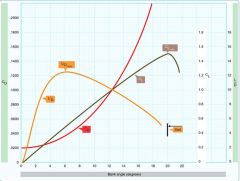
The lift/drag at 2° angle of attack is approximately the same as the lift/drag for a. 9.75° angle of attack. b. 10.5° angle of attack. c. 16.5° angle of attack. |
c. 16.5° angle of attack. |
|

At which angle of attack does the airplane travel the maximum horizontal distance per foot of altitude lost? a. 6°. b. 12.3°. c. 20°. |
a. 6°. |
|
|
Maximum gliding distance of an aircraft is obtained when a. parasite drag is the least. b. induced drag and parasite drag are equal. c. induced drag equals the coefficient of lift. |
b. induced drag and parasite drag are equal. |
|
|
If an increase in power tends to make the nose of an airplane rise, this is the result of the a. line of thrust being below the center of gravity. b. center of lift being ahead of the center of gravity. c. center of lift and center of gravity being collocated. |
a. line of thrust being below the center of gravity. |
|
|
When considering the forces acting upon an airplane in straight-and-level flight at constant airspeed, which statement is correct? a. Weight always acts vertically toward the center of the Earth. b. Thrust always acts forward parallel to the relative wind and is greater than drag. c. Lift always acts perpendicular to the longitudinal axis of the wing and is greater than weight. |
a. Weight always acts vertically toward the center of the Earth. |
|
|
Which statement is true regarding the forces acting on an airplane in a steady-state climb? a. The sum of all forward forces is greater than the sum of all rearward forces. b. The sum of all upward forces is greater than the sum of all downward forces. c. The sum of all upward forces is equal to the sum of all downward forces. |
c. The sum of all upward forces is equal to the sum of all downward forces. |
|
|
During a steady climb, the rate of climb depends on a. excess power. b. excess thrust. c. thrust available. |
a. excess power.
|
|
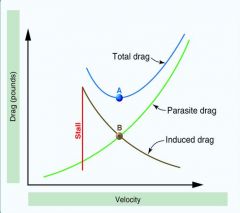
At the airspeed represented by point A, in steady flight, the aircraft will a. have its maximum lift/drag ratio. b. have its minimum lift/drag ratio. c. be developing its maximum coefficient of lift. |
a. have its maximum lift/drag ratio. |
|
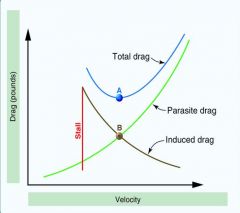
At an airspeed represented by point B, in steady flight, the pilot can expect to obtain the a. maximum coefficient of lift. b. minimum coefficient of lift. c. maximum glide range in still air. |
c. maximum glide range in still air. |
|
|
During a steady climb, the angle of climb depends on a. excess thrust. b. power available. c. thrust required. |
a. excess thrust. |
|
|
Which statement describes the relationship of the forces acting on an aircraft in a constant-power and constant-airspeed descent? a. thrust is equal to drag; lift is equal to weight. b. Thrust is equal to drag; weight is greater than lift. c. Thrust is greater than drag; weight is greater than lift. |
a. thrust is equal to drag; lift is equal to weight. |
|
|
During flight, advancing thrust will a. increase airspeed. b. cause the aircraft to climb. c. cause the aircraft to increase airspeed and climb. |
c. cause the aircraft to increase airspeed and climb |
|
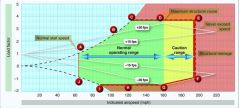
A positive load factor of 4 at 140 knots would cause the airplane to a. stall. b. break apart. c. be subjected to structural damage. |
c. be subjected to structural damage. |
|
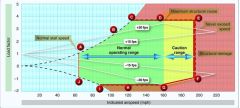
What load factor would be created if positive 30 feet per second gusts were encountered at 130 knots? a. 3.8. b. 3.0. c. 2.0. |
b. 3.0. |
|
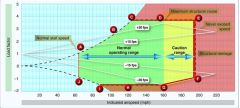
The horizontal dashed line from point B to point D represents the a. positive limit load factor. b. airspeed range for normal operations. c. maximum structural cruise airspeed range. |
a. positive limit load factor. |
|
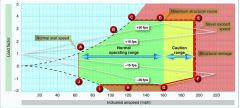
The airspeed indicated by point A is a. maneuvering speed. b. normal stall speed. c. maximum structural cruising speed. |
b. normal stall speed. |
|
|
The airspeed indicated by point B is a. maneuvering speed. b. never-exceed speed. c. maximum structural cruising speed. |
a. maneuvering speed.
|
|
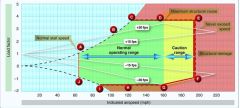
The airspeed indicated by point D is a. maneuvering speed. b. never-exceed speed. c. maximum structural cruising speed. |
b. never-exceed speed. |
|
|
The airspeed indicated by point C is a. maneuvering speed. b. never-exceed speed. c. maximum structural cruising speed. |
c. maximum structural cruising speed. |
|
|
If an airplane’s gross weight is 3,250 pounds, what is the load acting on this airplane during a level 60° banked turn? a. 3,250 pounds. b. 5,200 pounds. c. 6,500 pounds. |
c. 6,500 pounds. |
|
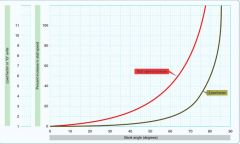
What increase in load factor would take place if the angle of bank were increased from 60° to 80°? a. 2 G’s. b. 3 G’s. c. 4 G’s. |
c. 4 G’s. |
|
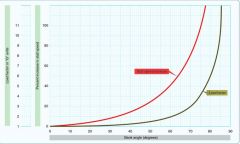
If, during a steady turn with a 50° bank, a load factor of 1.5 were imposed on an airplane which has an unaccelerated stall speed of 60 knots, at what speed would the airplane first stall? a. 68 knots. b. 75 knots. c. 82 knots. |
b. 75 knots.
|
|
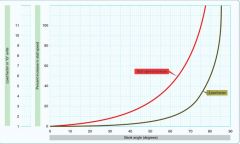
What is the stall speed of an airplane under a load factor of 4 if the unaccelerated stall speed is 70 knots? a. 91 knots. b. 132 knots. c. 140 knots. |
c. 140 knots. |
|
|
What is the stall speed of an airplane under a load factor of 2 if the unaccelerated stall speed is 100 knots? a. 115 knots. b. 129 knots. c. 140 knots. |
c. 140 knots. |
|
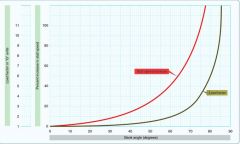
A 70 percent increase in stalling speed would imply a bank angle of a. 67°. b. 70°. c. 83°. |
b. 70°.
|
|
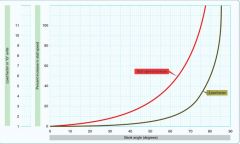
What is the stall speed of an airplane in a 30 degree bank turn if the level stall speed is 100 knots? a. 100 knots. b. 102 knots. c. 108 knots.
|
c. 108 knots. |
|
|
An airplane has a normal stalling speed of 60 MPH but is forced into an accelerated stall at twice that speed. What maximum load factor will result from this maneuver? a. 4 G’s. b. 2 G’s. c. 1 G. |
a. 4 G’s |
|
|
At a constant velocity in airflow, a high aspect ratio wing will have (in comparison with a low aspect ratio wing) a. increased drag, especially at a low angle of attack. b. decreased drag, especially at a high angle of attack. c. increased drag, especially at a high angle of attack. |
b. decreased drag, especially at a high angle of attack. |
|
|
The use of a slot in the leading edge of the wing enables an airplane to land at a slower speed because it a. changes the camber of the wing. b. delays the stall to a higher angle of attack. c. decelerates the upper surface boundary layer air. |
b. delays the stall to a higher angle of attack. |
|
|
A rectangular wing, as compared to other wing planforms, has a tendency to stall first at the a. wingtip providing adequate stall warning. b. wing root providing adequate stall warning. c. wingtip providing inadequate stall warning. |
b. wing root providing adequate stall warning. |
|
|
The angle between the chord line of the wing and the longitudinal axis of the aircraft is known as a. dihedral. b. the angle of attack. c. the angle of incidence. |
c. the angle of incidence. |
|

Which aircraft has the highest aspect ratio? a. 2. b. 3. c. 4. |
b. 3. |
|

Which aircraft has the lowest aspect ratio? a. 2. b. 3. c. 4. |
c. 4. |
|

Consider only aspect ratio (other factors remain constant). Which aircraft will generate greatest lift? a. 1. b. 2. c. 3. |
c. 3. |
|

Consider only aspect ratio (other factors remain constant). Which aircraft will generate greatest drag? a. 1. b. 3. c. 4. |
c. 4. |
|
|
Consider only aspect ratio (other factors remain constant). Which aircraft will generate the least drag? a. 16. b. 10. c. 9. |
b. 10. |
|
|
A line drawn from the leading edge to the trailing edge of an airfoil and equidistant at all points from the upper and lower contours is called the a. chord line. b. camber line. c. mean camber line. |
c. mean camber line. |
|
|
Which subsonic planform provides the best lift coefficient? a. Tapered wing. b. Elliptical wing. c. Rectangular wing. |
b. Elliptical wing. |
|
|
A sweptwing airplane with weak static directional stability and increased dihedral causes an increase in a. Mach tuck tendency. b. Dutch roll tendency. c. longitudinal stability. |
b. Dutch roll tendency. |
|
|
On which wing planform does the stall begin at the wing root and progress outward toward the wingtip? a. Sweepback wing. b. Rectangular wing. c. Moderate taper wing. |
b. Rectangular wing. |
|
|
The purpose of aircraft wing dihedral angle is to a. increase lateral stability. b. increase longitudinal stability. c. increase lift coefficient of the wing. |
a. increase lateral stability. |
|
|
Aspect ratio of a wing is defined as the ratio of the a. wingspan to the wing root. b. wingspan to the mean chord. c. square of the chord to the wingspan. |
b. wingspan to the mean chord.
|
|
|
A wing with a very high aspect ratio (in comparison with a low aspect ratio wing) will have a. a low stall speed. b. increased drag at high angles of attack. c. poor control qualities at low airspeeds. |
a. a low stall speed. |
|
|
The three axes of an aircraft intersect at the a. center of gravity. b. center of pressure. c. midpoint of the mean chord. |
a. center of gravity. |
|
|
Action of the elevators moves the airplane on its a. Lateral axis. b. Longitudinal axis. c. Vertical axis. |
a. Lateral axis. |
|
|
Action of the ailerons moves the airplane on its a. lateral axis. b. longitudinal axis. c. vertical axis. |
b. longitudinal axis. |
|
|
If the pilot applies right rudder to a stable airplane, the a. tail deflects right and the nose moves right. b. tail deflects left and the nose moves right. c. tail deflects right and the nose moves left. |
b. tail deflects left and the nose moves right.
|
|
|
The angle between the chord line of an airfoil and the relative wind is known as the angle of a. lift. b. attack. c. incidence. |
b. attack.
|
|
|
The critical angle of attack at which a given aircraft stalls is dependent on the a. gross weight. b. design of the wing. c. attitude and airspeed. |
b. design of the wing. |
|
|
The angle of attack of a wing directly controls the a. angle of incidence of the wing. b. amount of airflow above and below the wing. c. distribution of positive and negative pressure acting on the wing. |
c. distribution of positive and negative pressure acting on the wing. |
|
|
As the angle of bank is increased, the vertical component of lift a. increases and the sink rate increases. b. decreases and the sink rate increases. c. increases and the sink rate decreases. |
b. decreases and the sink rate increases. |
|
|
How can a pilot increase the rate of turn and decrease the radius at the same time? a. Shallow the bank and increase airspeed. b. Steepen the bank and decrease airspeed. c . Steepen the bank and increase airspeed. |
b. Steepen the bank and decrease airspeed. |
|
|
What action is necessary to make an aircraft turn? a. Yaw the aircraft. b. Change the direction of lift. c. Change the direction of thrust. |
b. Change the direction of lift.
|
|

While rolling into a right turn, if the inclinometer appears as illustrated in A, the HCL and CF vectors would be acting on the aircraft as illustrated in a. 2, and more left pedal pressure is needed to center the ball. b. 2, and more right pedal pressure is needed to center the ball. c. 4, and more right pedal pressure is needed to center the ball. |
b. 2, and more right pedal pressure is needed to center the ball. |
|
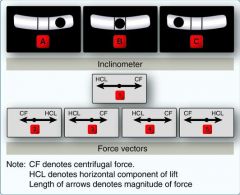
While rolling into a right turn, if the inclinometer appears as illustrated in C, the HCL and CF vectors would be acting on the aircraft as illustrated in a. 3, and less right pedal pressure is needed to center the ball. b. 5, and less right pedal pressure is needed to center the ball. c. 5, and more right pedal pressure is needed to center the ball. |
b. 5, and less right pedal pressure is needed to center the ball. |
|
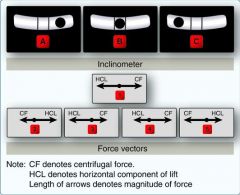
While rolling out of a left turn, if the inclinometer appears as illustrated in A, the HCL and CF vectors would be acting on the aircraft as illustrated in a. 4, and more right pedal pressure is needed to center the ball. b. 4, and more left pedal pressure is needed to center the ball. c. 2, and more right pedal pressure is needed to center the ball. |
a. 4, and more right pedal pressure is needed to center the ball. |
|
|
Adverse yaw during a turn entry is caused by a. increased induced drag on the lowered wing and decreased induced drag on the raised wing. b. decreased induced drag on the lowered wing and increased induced drag on the raised wing. c. increased parasite drag on the raised wing and decreased parasite drag on the lowered wing. |
b. decreased induced drag on the lowered wing and increased induced drag on the raised wing. |
|
|
When rolling out of a steep-banked turn, what causes the lowered aileron to create more drag than when rolling into the turn? a. The wing’s angle of attack is greater as the rollout is started. b. The wing being raised is traveling faster through the air than the wing being lowered. c. The wing being lowered is traveling faster through the air and producing more lift than the wing being raised. |
a. The wing’s angle of attack is greater as the rollout is started.
|
|
|
The quality of an aircraft that permits it to be operated easily and to withstand the stresses imposed on it is a. stability. b. maneuverability. c. controllability. |
b. maneuverability.
|
|
|
The capability of an aircraft to respond to a pilot’s inputs, especially with regard to flightpath and attitude, is a. response. b. controllability. c. maneuverability. |
b. controllability.
|
|
|
The tendency of an aircraft to develop forces which restore it to its original condition, when disturbed from a condition of steady flight, is known as a. stability. b. controllability. c. maneuverability. |
a. stability.
|
|
|
The most desirable type of stability for an aircraft to possess is a. neutral static stability. b. positive static stability. c. positive dynamic stability. |
c. positive dynamic stability. |
|
|
Which aircraft characteristics contribute to spiral instability? a. Weak static directional stability and weak dihedral effect. b. Strong static directional stability and weak dihedral effect. c. Weak static directional stability and strong dihedral effect. |
b. Strong static directional stability and weak dihedral effect. |
|
|
The tendency of an aircraft to develop forces that further remove the aircraft from its original position, when disturbed from a condition of steady flight, is known as a. static instability. b. dynamic instability. c. positive static stability. |
a. static instability.
|
|
|
If the aircraft’s nose initially tends to return to its original position after the elevator control is pressed forward and released, the aircraft displays a. positive static stability. b. neutral dynamic stability. c. negative dynamic stability. |
a. positive static stability.
|
|
|
If the aircraft’s nose initially tends to move farther from its original position after the elevator control is pressed forward and released, the aircraft displays a. negative static stability. b. positive static stability. c. positive dynamic stability. |
a. negative static stability.
|
|
|
If the aircraft’s nose remains in the new position after the elevator control is pressed forward and released, the aircraft displays a. neutral static stability. b. negative static stability. c. positive static stability. |
a. neutral static stability.
|
|
|
If the airspeed increases and decreases during longitudinal phugoid oscillations, the aircraft a. will display poor trimming qualities. b. is maintaining a nearly constant angle of attack. c. is constantly changing angle of attack making it difficult for the pilot to reduce the magnitude of the oscillations. |
b. is maintaining a nearly constant angle of attack.
|
|
|
If an aircraft has negative dynamic and positive static stability, this will result in a. undamped oscillations. b. divergent oscillations. c. convergent oscillations. |
b. divergent oscillations.
|
|
|
With regard to gyroscopic precession, when a force is applied at a point on the rim of a spinning disc, the resultant force acts in which direction and at what point? a. In the same direction as the applied force, 90° ahead in the plane of rotation. b. In the opposite direction of the applied force, 90° ahead in the plane of rotation. c. In the opposite direction of the applied force, at the point of the applied force. |
a. In the same direction as the applied force, 90° ahead in the plane of rotation.
|
|
|
As a result of gyroscopic precession, it can be said that any a. pitching around the lateral axis results in a rolling moment. b. yawing around the vertical axis results in a pitching moment. c. pitching around the longitudinal axis results in a yawing moment. |
b. yawing around the vertical axis results in a pitching moment.
|
|
|
A propeller rotating clockwise, as seen from the rear, creates a spiraling slipstream that tends to rotate the aircraft to the a. right around the vertical axis, and to the left around the longitudinal axis. b. left around the vertical axis, and to the right around the longitudinal axis. c. left around the vertical axis, and to the left around the longitudinal axis. |
b. left around the vertical axis, and to the right around the longitudinal axis.
|
|
|
The angle of attack at which an airplane stalls a. increases with an increase in engine power. b. remains constant regardless of gross weight. c. varies with gross weight and density altitude. |
b. remains constant regardless of gross weight.
|
|
|
Which action will result in a stall? a. Flying at too low an airspeed. b. Raising the aircraft’s nose too high. c. Exceeding the critical angle of attack. |
c. Exceeding the critical angle of attack. |
|
|
Which statement is true relating to the factors which produce stalls? a. The critical angle of attack is a function of the degree of bank. b. The stalling angle of attack depends upon the speed of the airflow over the wings. c. The stalling angle of attack is independent of the speed of airflow over the wings. |
c. The stalling angle of attack is independent of the speed of airflow over the wings. |
|
|
Which characteristic of a spin is not a characteristic of a steep spiral? a. Stalled wing. b. High rate of rotation. c. Rapid loss of altitude. |
a. Stalled wing.
|
|
|
Which statement is true concerning the aerodynamic conditions which occur during a spin entry? a. After a full stall, both wings remain in a stalled condition throughout the rotation. b. After a partial stall, the wing that drops remains in a stalled condition while the rising wing regains and continues to produce lift, causing the rotation. c. After a full stall, the wing that drops continues in a stalled condition while the rising wing regains and continues to produce some lift, causing the rotation. |
c. After a full stall, the wing that drops continues in a stalled condition while the rising wing regains and continues to produce some lift, causing the rotation. |
|
|
It is possible to fly an aircraft just clear of the ground at a slightly slower airspeed than that required to sustain level flight at higher altitudes. This is the result of a. interference of the ground surface with the airflow patterns about the aircraft in flight. b. a cushioning effect of the air as it is trapped between the ground and the descending aircraft. c. ground interference with the static pressure system which produces false indications on the airspeed indicator. |
a. interference of the ground surface with the airflow patterns about the aircraft in flight. |
|
|
If the same angle of attack is maintained in ground effect as when out of ground effect, lift will a. increase, and induced drag will decrease. b. decrease, and parasite drag will increase. c. decrease, and parasite drag will decrease. |
a. increase, and induced drag will decrease.
|
|
|
An airplane is usually affected by ground effect at what height above the surface? a. Three to four times the airplane’s wingspan. b. Twice the airplane’s wingspan above the surface. c. Less than half the airplane’s wingspan above the surface. |
c. Less than half the airplane’s wingspan above the surface. |
|
|
An airplane leaving ground effect will a. experience a decrease in thrust required. b. experience a decrease in stability and a nose-up change in moments. c. require a lower angle of attack to attain the same lift coefficient. |
b. experience a decrease in stability and a nose-up change in moments.
|
|
|
If severe turbulence is encountered, the aircraft’s airspeed should be reduced to a. maneuvering speed. b. normal structural cruising speed. c. the minimum steady flight speed in the landing configuration. |
a. maneuvering speed.
|
|
|
Which is the best technique for minimizing the wing-load factor when flying in severe turbulence? a. Control airspeed with power, maintain wings level, and accept variations of altitude. b. Control airspeed as closely as possible with elevator and power, and accept variations of bank and altitude. c. Set power and trim to obtain an airspeed at or below maneuvering speed, maintain wings level, and accept variations of airspeed and altitude. |
c. Set power and trim to obtain an airspeed at or below maneuvering speed, maintain wings level, and accept variations of airspeed and altitude. |

